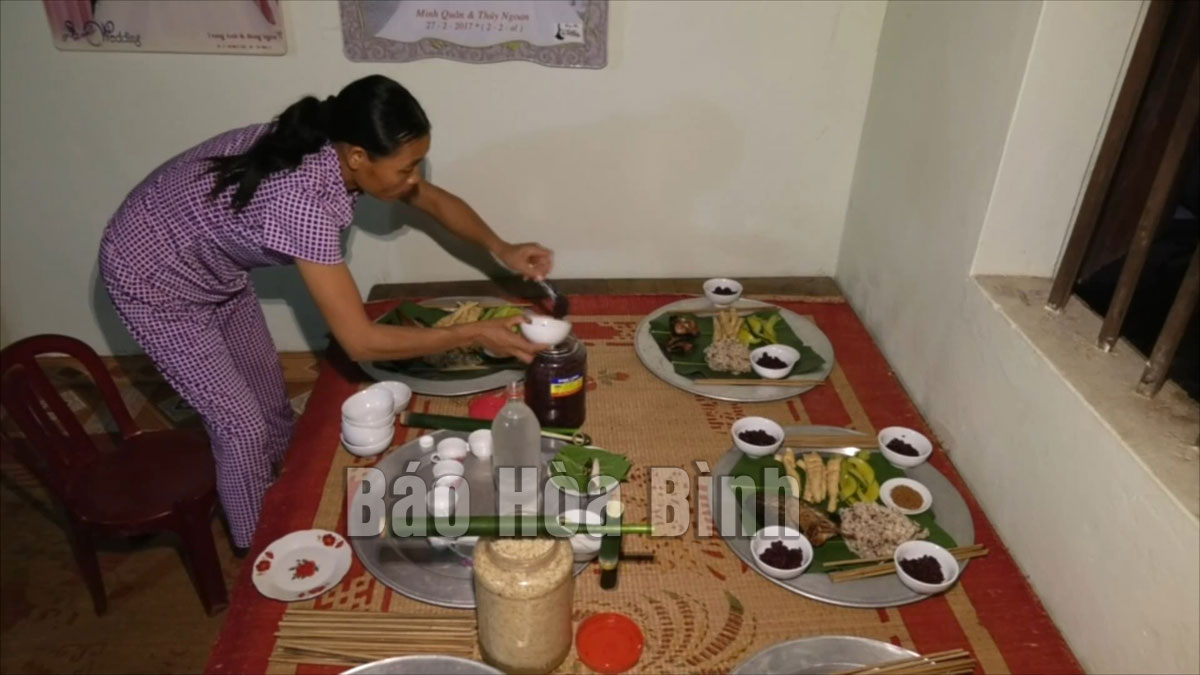



Muong people in Ram village, Lac Thinh commune (Yen Thuy) are preparing De Rice Festival.
The elders in Muong Ram area say that, there were two Lang Cun named Cun Ram and Dao Trac, who openly cleared and built the land of Muong Ram and Muong Trac today. Mr. Lang Cun was the ruler, governing the whole land of Ram with the desire of "the peaceful state, the people's safety”. He noticed that the people's life was extremely miserable, the rich people were few while the poor were more, so before he passed away, Lang Cun told the clans, the families and descendants that after the harvest was complete, the people had the sticky rice to eat and worship the ancestors, then it was necessary to make a vegetarian meal to worship the village's Thanh Hoang, the great grandparents and the ancestors in the family, praying for health, peace and the prosperous business. At that time, due to the economic conditions, the people only worshiped and had vegetarian dishes. The vegetarian dishes ordered by Mr. Lang Cun included bamboo shoots, papaya, boiled melon, roasted sesame without salt, De rice and steamed sticky rice.
Usually, about 5-6 days before, the people prepared for De Rice ceremony. In order to have the delicious, sweet, fragrant De rice, it is necessary to carefully choose the glutinous rice. It must be the rice grown on the hillsides, which is pounded to remove the husks, then it is sieved and soaked in water for 3-4 hours, then it is picked up and put in a wooden pot and steamed. When the rice is well-done enough, it is taken out a large basket to cool. Remember that the glutinous rice used to make De rice must not be cooked as it is be crushed without the whole grain. When the rice cools, brew it. First of all, sprinkle some cool boiled water on the rice so that the rice grains no longer stick together, then sprinkle yeast over each layer of rice until it is really even before putting the rice in the basket. The basket is lined with a sealed layer of banana leaves, so that the rice does not soak the yeast and water out. For the yeast to brew De rice, as passed down by the ancestors and the experience ofMuong Ram people, the yeast used to brew De rice is a combination of leaves, roots, and tubers in the forest.
The rice that is incubated for 2 days in a basket for fermentation is called De rice. At this time, the families in Muong Ram and Muong Trac put De rice in the pots made of crock or porcelain, and they wait for the right time to worship the village's Thanh Hoang, to worship the ancestors, then tghey invite relatives and friends. and the family guests.
According to Mr. Bui Ngoc Luong, the Chairman of Lac Thinh People's Committee, De rice festival in Muong Ram has only a ceremony, withour a festival, and the ceremony is held individually in each household. On this day, the people put aside the work in the fields to prepare the vegetarian food in each household. The offerings must necessarily take place before the sunrise (at 4 a.m) to avoid some animals. They are spiders that have not yet spread their webs, flies have not yet laid eggs, and this is called a clean offering tray. The family members have to make an appointment with the shaman and pick him up at his house from dawn. The tray is placed in the center of the house. Depending on each family’s conditions, it can be presented from 1, 2 to 3 trays of offerings. Remembering Lang Cun's advice, the families prepare full offerings, it is indispensable De rice, sticky rice, white wine, bamboo shoots, melon fruit, boiled papaya, sesame without salt.
When the ceremony ends, it is also time for the whole family to sit down, chatting and enjoying the offerings and everyone has to enjoy a little De rice to get luck. Until it is dawn, the family continues preparing other dishes to welcome friends and guests. On this day, the descendants and the friends who work far away return to their homeland to celebrate De Rice Fesstival with their families, relatives, and neighbors. The people here also show their hospitality through the sayings "uninvited guests are valued guests”. On De Rice Festival, no one has to invite anyone, they themselves know it and come tho visit each other.
Nowadays the, economic conditions have developed, the material and spiritual life of the people in Muong Ram and Muong Trac has been improved. De Rice Festival is now richer, most families have savory meals, slaughter pigs and chickens, and prepare many delicious dishes to welcome guests. In the rice tray of offerings to ancestors and the meals, it is still indispensable to have steamed vegetables and pickled vegetables. The guests coming to the family just eat De rice to remember the taste nand to raise a cup of wine to ask about each other's healthy status, welcoming the warm atmosphere of solidarity, friendship and feeling the traditional cultural beauty of the De Rice Festival in Muong Ram and Muong Trac. Everyone wishes each other a new year with many changes, good health, and a happy family. The owner responds to the wishes of the guest, asking the guest to come back for a bigger tray of De Rice ext year.